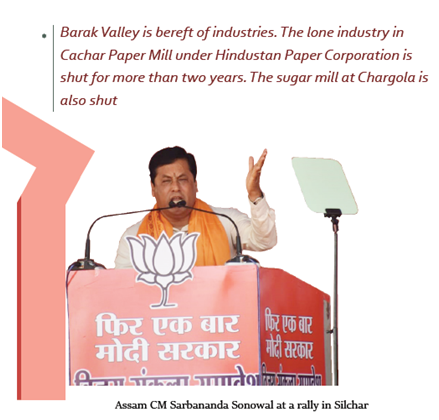
The elections are over. The brazen cockfight between the warring political parties is over. By the time this article will be published, the third phase of Lok Sabha polls will be over in Assam and the raging debate on Citizenship (Amendment) Bill 2016 that dominated the campaign trail in this election will go into oblivion.
Congress’ Nyunatam Aay Yojana (NYAY) seems to be the flavour of the season—at least for the beleaguered party Chief Rahul Gandhi. The irony of Indian politics is that all the parties rely on doles since they believe that doles are the only route to the corridors of power in Delhi.
Keeping aside the political stories, this scribe has tried to touch upon a not so debated issue—can Barak Valley be turned into a trade hub?
Gone are the days when Northeast used to be considered as one of the neglected zones. Today the situation has changed and the seven sisters are receiving financial packages from Delhi. How far these packages have been used properly, it’s for analysts to think about.
Recently the Gandhi scion while addressing a poll rally in Barak Valley’s Panchgram area told the crowd, “If Congress returns to power in Delhi, our government will make Barak Valley a trade hub.”
Though it sounds to be a great idea, for reasons best known to him the Gandhi scion didn’t elaborate on this idea. The ongoing debate on citizenship bill has further widened the gap between Barak and Brahmaputra.
The brutal crackdown on language movement in Barak Valley on May 19, 1961, is still afresh in the minds of denizens of this part of Southern Assam.
Time and again the demand for a separate Barak is raised but this ‘wish’ of few has failed to ring a bell so far. Assam is laced with enormous natural resources. If these resources can be properly utilized, not only the economic plight of the people will improve at the same time jobs can be created as well.
In today’s globalised world no nation can afford to remain isolated. In the early 1990s, Northeast was reeling under terrorism—the situation has improved and this is the opportune time to give a fillip to trade and commerce.
As mentioned earlier that the Northeastern states depend heavily on Central aid—by going through the distribution of financial assistance to Assam by Delhi in 2016-2017 fiscal year, the state government received around Rs 66,180 crore from the centre.
Of this amount 68 per cent has been provided by Delhi and the remaining 32 per cent has been borne by Assam government. This shows that the state is not yet ready to stand on its own legs.
While participating in Namami Barak festival, President Ram Nath Kovind said that the trade with Bangladesh will get a boost because the Border Trade Centre is located in Karimganj.
The First Citizen of India also mentioned about Modi government’s Act East Policy and opined that this policy has been undertaken keeping the geographical location of Northeast.
Barak Valley is the gateway to Manipur, Meghalaya, Mizoram and Tripura. Following the completion of Silchar—Lumding gauge conversion project the communication connectivity has improved significantly and this is the right time to explore the resources of Barak Valley.
The main problem in Barak Valley or elsewhere in India is that the main issues are ignored by the political parties and they try to set the agenda on the basis of caste, community and religion. Barak Valley shares a porous border with Bangladesh. The Sutarkandi trade centre is lying unattended and businesses are carried out illegally.
In Sutarkandi bulk of the trade is taking place in an illegal manner. The authorities concerned need to ponder over this issue and should try to formalize the illegal trade. This will boost the local economy.
If the trade infrastructure in Sutarkandi can be properly utilized, this will not only help the local traders—at the same time, it will also create ample opportunities for people working in the unorganized sector.
Assam has got four oil refineries in Digboi, Noonmati, Numaligarh and Bongaigaon. Though Barak Valley has no oil refinery, Oil & Natural Gas Corporation Limited (ONGC) has upgraded its forward base in Srikona. This indicates that Barak Valley has got plenty of oil under its surface.
This area too can be explored—if at all the political masters are thinking to make a trade hub in Barak Valley.
Barak Valley is bereft of industries. The lone industry in Cachar Paper Mill under Hindustan Paper Corporation is shut for more than two years. The sugar mill at Chargola is also shut.
At a time when plans are being discussed to make Barak Valley a trade hub, the policymakers should try to revive these mills because this will not only create jobs but will also boost the local economy.
During Namami Barak fiesta amidst much fanfare, the Chief Minister announced of his government’s plan to dredge the mighty Barak River. If sources are to be believed, the dredging work is going on.
In fact, Union Minister of State for Shipping Pon Radhakrishnan during his tour in Barak Valley told, that the aim of the central government is to bring the Barak Valley in the shipping map. If at all, the state government succeeds in its mission, certainly this will open new avenues for Barak Valley because international trade with South Asian countries will get a new momentum.
Satraajit Palchoudhury
To read the further articles please get your copy of Eastern Panorama May issue @http://www.magzter.com/IN/Hill-Publications/Eastern-Panorama/News/ or mail to contact @easternpanorama.in

